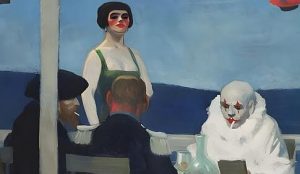Soir Bleu is a story of obsession and revenge. Butler is careful when crafting the inner thoughts of our narrator, who himself represents deep obsession and desire. The narrator is in close proximity to Solange, who he feels some sort of ownership over. He credits himself as her “savior” and is obsessed with the image he creates of her in his paintings. He sees Solange not as a person of her own making, but as a woman who he has perfected in his arts. It is his understanding that she also shares this insight and no longer values herself as her own, but as a product of his creation. “We have come to understand, Solange and I, that in the deepest sense she no longer exists except in my hand” (Butler 43). This understanding is revealed to be one sided and as the narrator discovers this, we see just how deep his obsessions and his desires drive him to a violent revenge.
 While the theme of obsession is prevalent throughout Butler’s story, where is it in the painting? Soir Bleu is often found to capture themes of isolation within the characters depicted. In the painting, we can see four uniquely dressed individuals, while all posed carefully together, are lonesome in their own aesthetics. We can see that the clown, dressed in a luminosity white attire and a painted face stands out the most. As the clown captures the eye for the aesthetic, there is also a look not familiar with the common stereotype of clowns. While clowns are typically depicted with a smile, the clown in Soir Bleu is nonchalant, boarding a look of sadness. As viewers, it is obvious that while the clown is surrounded by people, the clown is not particularly overjoyed by the company. The contrast of the clown’s apperence and those that sit with him at the table create a certain visual division between the four.
While the theme of obsession is prevalent throughout Butler’s story, where is it in the painting? Soir Bleu is often found to capture themes of isolation within the characters depicted. In the painting, we can see four uniquely dressed individuals, while all posed carefully together, are lonesome in their own aesthetics. We can see that the clown, dressed in a luminosity white attire and a painted face stands out the most. As the clown captures the eye for the aesthetic, there is also a look not familiar with the common stereotype of clowns. While clowns are typically depicted with a smile, the clown in Soir Bleu is nonchalant, boarding a look of sadness. As viewers, it is obvious that while the clown is surrounded by people, the clown is not particularly overjoyed by the company. The contrast of the clown’s apperence and those that sit with him at the table create a certain visual division between the four.
Robert Butler’s story connects themes of obsession to the painting’s theme of isolation. In the story, with the narrator’s isolated perspective on Solange and their relationship, he is dumb sided and evidently finds himself lonesome. It seems in the story that his own obsession and feeling of ownership over Solange drives him to his state of lonesomeness after he carries out revenge. As according to the story and the painting, the character’s own individualism, such as the narrator’s drives everyone to isolation.
Obsession with control is an excellent way to state it. I also find Vachon’s assumption of what everyone around him is thinking to be a sort of desperation for control. Perhaps it’s an outcome of the incredibly traumatic events of his childhood. I am curious, as someone else who took Varieties of the Fantastic last year, how real you thought the ending was. As in, whether the apparition was real or not.